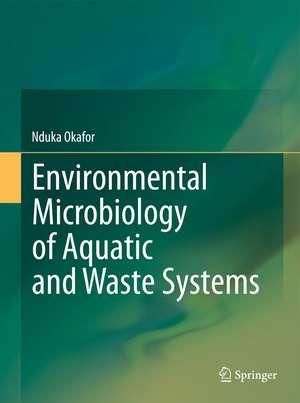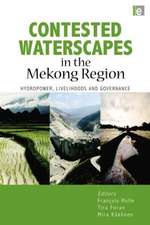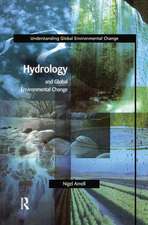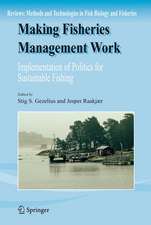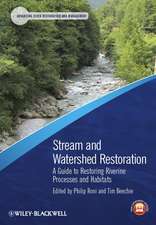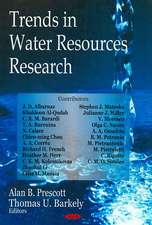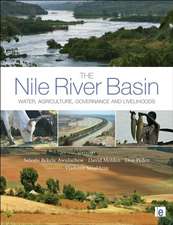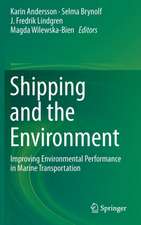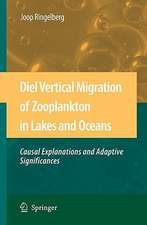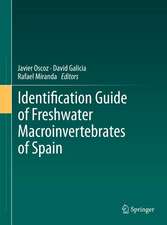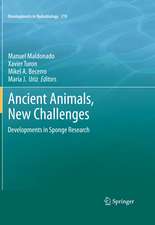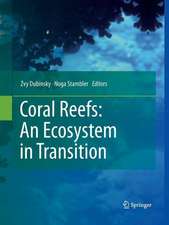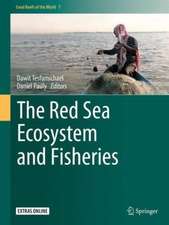Environmental Microbiology of Aquatic and Waste Systems
Autor Nduka Okaforen Limba Engleză Paperback – 23 noi 2014
| Toate formatele și edițiile | Preț | Express |
|---|---|---|
| Paperback (1) | 389.88 lei 38-44 zile | |
| SPRINGER NETHERLANDS – 23 noi 2014 | 389.88 lei 38-44 zile | |
| Hardback (1) | 423.34 lei 38-44 zile | |
| SPRINGER NETHERLANDS – 22 iun 2011 | 423.34 lei 38-44 zile |
Preț: 389.88 lei
Nou
Puncte Express: 585
Preț estimativ în valută:
74.61€ • 81.02$ • 62.67£
74.61€ • 81.02$ • 62.67£
Carte tipărită la comandă
Livrare economică 18-24 aprilie
Preluare comenzi: 021 569.72.76
Specificații
ISBN-13: 9789400794320
ISBN-10: 9400794320
Pagini: 324
Ilustrații: XVI, 307 p.
Dimensiuni: 193 x 260 x 17 mm
Greutate: 0.69 kg
Ediția:2011
Editura: SPRINGER NETHERLANDS
Colecția Springer
Locul publicării:Dordrecht, Netherlands
ISBN-10: 9400794320
Pagini: 324
Ilustrații: XVI, 307 p.
Dimensiuni: 193 x 260 x 17 mm
Greutate: 0.69 kg
Ediția:2011
Editura: SPRINGER NETHERLANDS
Colecția Springer
Locul publicării:Dordrecht, Netherlands
Public țintă
Lower undergraduateCuprins
Part I - Introduction: Nature, Properties, and Distribution of Water.-Peculiarities of Water as an Environmental Habitat for Microorganisms.-Part II- Biological Aspects of Microorganisms in Aquatic Environments: Aspects of the Molecular Biology of Microorganisms of Relevance to the Aquatic Environment.-Taxonomy, Physiology and Ecology of Aquatic Microorganisms.-Part III - The Ecology of Microorganisms in Natural Waters.- Ecology of Microorganisms in Freshwater.- Ecology of Microorganisms in Saline Waters (Seas and Oceans).-Part IV - Pollution and Purification of, and Disease Transmission in, Water: Pollution of Aquatic Systems: Pollution through Eutrophication, Fecal Materials and Oil Spills.-Disease Transmission in Water.-Purification of Water.-Part V - Waste Disposal in Aquatic and Solid Media: Waste Disposal in the Aqueous Medium: Sewage Disposal.-Waste Disposal in Solid Media: The Disposal of Municipal Solid Wastes (MSW).-Index.
Recenzii
From the reviews:
“The author explores the environmental systems and links them with the ecology of microorganisms. … Each of the well-written topics presented contains current and practical information. The book is based on a course taught by the author; therefore, it is useful for both undergraduates and beginning graduate students in microbiology, public health, aquatic science, and civil/environmental engineering. The work is also valuable for practitioners lacking microbiology or biology backgrounds … . Summing Up: Recommended. Upper-division undergraduates and above.” (M. E. Lenczewski, Choice, Vol. 49 (7), March, 2012)
“The author explores the environmental systems and links them with the ecology of microorganisms. … Each of the well-written topics presented contains current and practical information. The book is based on a course taught by the author; therefore, it is useful for both undergraduates and beginning graduate students in microbiology, public health, aquatic science, and civil/environmental engineering. The work is also valuable for practitioners lacking microbiology or biology backgrounds … . Summing Up: Recommended. Upper-division undergraduates and above.” (M. E. Lenczewski, Choice, Vol. 49 (7), March, 2012)
Textul de pe ultima copertă
This book seeks to place the main actors in matters of environmental microbiology, namely the microorganisms, on center stage. Using the modern approach of 16S ribosomal RNA, the book looks, in great detail, at the taxonomy of marine and freshwater bacteria, fungi, protozoa, algae, viruses, and the smaller aquatic animals such as nematodes and rotifers, as well as at the study of unculturable aquatic microorganisms (metagenomics).
The peculiarities of water as an environment for microbial growth, and the influence of aquatic microorganisms on global climate and global recycling of nitrogen and sulphur are also examined. The pollution of water is explored in the context of self-purification of natural waters. Modern municipal water purification and disease transmission through water are discussed. Alternative methods for solid waste disposal are related to the economic capability of a society.
Viruses are given special attention because, until recently, it was thought they were not important in aquatic environments. The modern understanding is that they are not only abundant, but play a crucial role in the sustenance of the various components of the biological ecosystem in aquatic environments.
The book will be useful to a wide range of undergraduate and graduate students, as well as relevant practitioners in microbiology, general biology, environmental science, public health and civil (sanitary) engineering.
The peculiarities of water as an environment for microbial growth, and the influence of aquatic microorganisms on global climate and global recycling of nitrogen and sulphur are also examined. The pollution of water is explored in the context of self-purification of natural waters. Modern municipal water purification and disease transmission through water are discussed. Alternative methods for solid waste disposal are related to the economic capability of a society.
Viruses are given special attention because, until recently, it was thought they were not important in aquatic environments. The modern understanding is that they are not only abundant, but play a crucial role in the sustenance of the various components of the biological ecosystem in aquatic environments.
The book will be useful to a wide range of undergraduate and graduate students, as well as relevant practitioners in microbiology, general biology, environmental science, public health and civil (sanitary) engineering.
Caracteristici
Will appeal to a wide range of disciplines needing a grounding in aquatic microbiology Presents the ideas in the coherent and unified manner required in undergraduate texts Fills a gap in the literature by focusing on the basics
